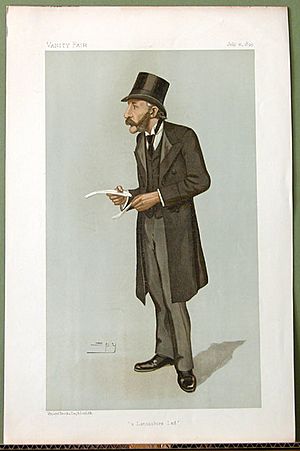Henry Hoyle Howorth facts for kids
Quick facts for kids
Sir
Henry Hoyle Howorth
|
|
|---|---|

"A Lancashire Lad". Caricature by Spy published in Vanity Fair (1895)
|
|
| Born | 1842 |
| Died | 1923 |
| Nationality | British |
| Occupation | |
| Spouse(s) | Katherine Brierley |
| Children | Sir Rupert Howorth |
| Relatives | Sir Edmund Ronald Leach (Grand-uncle) |
Sir Henry Hoyle Howorth (born July 1, 1842 – died July 15, 1923) was a British politician, lawyer, and a keen amateur historian and geologist. He was known for his many interests and his strong opinions.
Contents
Life and Work
Henry Howorth was born in Lisbon, Portugal. His father was a merchant there. Henry went to Rossall School and then studied law. In 1867, he became a barrister, which is a type of lawyer who argues cases in court. He worked as a lawyer in the northern part of England.
A Career in Politics
Howorth was a Conservative politician. He believed in keeping the United Kingdom together, which was called "Unionism" at the time. In 1886, he was elected as a Member of Parliament (MP) for Salford South. An MP is a person elected to represent a group of people in the country's parliament. He was re-elected twice and served in the House of Commons until 1900.
Other Interests and Achievements
Beyond law and politics, Howorth loved learning about many things. He was very interested in archaeology (studying old human history), history, numismatics (collecting and studying coins), and ethnography (studying different cultures). He wrote many articles for various journals.
In 1892, he received a special award and became a Knight Commander of the Indian Empire. This was to recognize his important writings about the history and cultures of Asia. The next year, in 1893, he became a Fellow of the Royal Society. This is a big honor for scientists, even though he didn't have a formal science degree.
He also held important positions, such as the Honorary Librarian of Chetham's College, Manchester. He was also a Trustee of the British Museum, which is a famous museum in London.
Howorth was known for sharing his strong opinions. He often wrote letters to The Times newspaper, sometimes using a secret name. He married Katherine Brierley in 1869, and they had three sons. One of their sons was Sir Rupert Howorth. Sir Henry Howorth passed away in 1923 at the age of 81.
Ideas About Earth's History
Henry Howorth had some interesting ideas about how the Earth changed over time. Most scientists at the time believed in uniformitarianism. This idea says that the Earth's surface was shaped slowly over long periods by the same processes we see today, like erosion and small changes.
However, Howorth disagreed. He believed in a form of diluvialism, which suggests that huge, sudden floods had changed large parts of the Earth. This idea is sometimes called "neo-catastrophism" because it involves big, sudden events.
Challenging the Ice Age Theory
Howorth specifically challenged the idea of the ice age. The ice age theory says that huge sheets of ice covered much of the Earth in the past. In his book The Mammoth and the Flood (1887), he argued against this. He thought that giant floods, not ice, were responsible for many of the things geologists saw in the Earth's rocks.
He didn't think there was one single global flood, like the one in some ancient stories. Instead, he thought there were many large floods. He used geological evidence to support his flood theory in another book, The Glacial Nightmare and the Flood (1893). In 1905, he wrote Ice or Water? to further argue against the ice age theory. However, most professional geologists were not convinced by his ideas.
Major Books and Writings
Sir Henry Howorth wrote many books and articles, showing his wide range of interests:
On Asian History
- H.H. Howorth (霍渥斯), History of the Mongols (in three-volumes, 1876–88):
- History of the Mongols: The Mongols proper and the Kalmuks: Part I
- History of the Mongols, from the 9th to the 19th Century: Part I
- H.H. Howorth, History of Chinghis Khan and his Ancestors.
- H.H. Howorth, "The Spread of the Slaves, Part III: The Northern Serbs or Sorabians and the Obodoiti", The Journal of the Anthropological Institute of Great Britain and Ireland, 9 (1880), pp. 181–232.
On English Church History
- H.H. Howorth, The History of the Church in England to the Eighth Century (in three volumes, 1912–17):
- Saint Gregory the Great (1912);
- Saint Augustine of Canterbury (1913); and
- The Golden Days of the Early English Church (1917).
On Geology and Earth's Past
In his geological books, he argued against the ideas of Charles Lyell and the ice age theory, favoring his flood theories:
- H.H. Howorth, The Mammoth and the Flood (1887);
- H.H. Howorth, The Glacial Nightmare (1893); and
- H.H. Howorth, Ice or Water? (1905).

